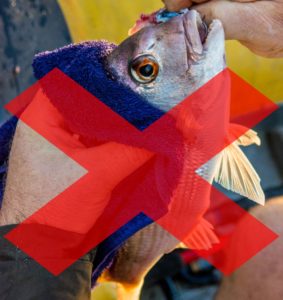
Snapper are serial spawners and their reproductive strategy is to mass-produce their eggs and broadcast them over a wide area in the hope that a few of their offspring will survive. This is one of nature’s clever approaches to survival of a species. In the case of snapper, it works, because there is a high rate of mortality for the baby ones (like in the larvae stage) that don’t make it.
What are the odds of surviving? Well not too different to winning the lotto. That kind of puts things in perspective when it comes to looking after the undersized fish that we release. We need to first respect that those little goldfish were pretty lucky, until they ended up on our hook.
If the chances of dying are so high, how do we increase their chances of survival?
Using lures when fishing will catch fewer small snapper and lip hook them more often which gives them a better chance of living when released. Filing or crushing down the barb will make it easy to remove the fish from the hook. It can be quite harmful for the fish to be firmly squeezed as a large-handed fisher tries to rip a hook out of its jaw because the barb keeps catching on its skin.

Steady pressure on the fish when pulling it to the boat (or shore) will mean barbless hooks will still catch as many as those with a barb. In fact, there may be an argument that barbless hooks have more success because it is easier to penetrate the fish’s mouth because the barb is absent.
If you can release a fish whilst it is still in the water, even better. If it is a stroppy little fighter and you foresee a few spines in the finger as it struggles for freedom, holding it in a rubber mesh net and using a pair of pliers is the safest approach for both fish and fisher.
A word of warning – please don’t use a dry or wet cloth when holding fish prior to release. The fabric can remove the precious mucus from the fish and make it susceptible to infection on release. The mucus helps provide a barrier for disease and if this is removed by rubbing or if scales are lost because of flapping around and banging against the boat, it can be the end of the fish.

It has been popular practice to use a cloth, but it isn’t best practice so please instead try the above first – remove your barbs so releasing the fish in the water is easy, use a rubber net to contain stroppy fish and as a last resort use wet hands to handle fish. You can use the cloth on your hands afterwards, but please don’t use it on the fish. Summertime can be the time of lots of baby snapper make a nuisance of themselves but remember those were the very lucky ones, ensuring their survival can only do good for our fishery.


